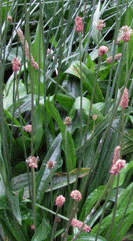 Buckhorn plantain is a perennial weed native to Eurasia introduced by European settlers when they came to American. It is now found throughout the United States including Alaska and Hawaii. It prefers full sun and medium to dry, heavy soil but tolerates some shade and many different soil types. It is common in disturbed areas and is especially troublesome in lawns but also grows in gardens, orchards, pastures, vacant lots, roadsides, and other waste areas.
Buckhorn plantain is a perennial weed native to Eurasia introduced by European settlers when they came to American. It is now found throughout the United States including Alaska and Hawaii. It prefers full sun and medium to dry, heavy soil but tolerates some shade and many different soil types. It is common in disturbed areas and is especially troublesome in lawns but also grows in gardens, orchards, pastures, vacant lots, roadsides, and other waste areas.

 Description: Plants consist of a rosette of basal leaves and one or more flowering stems with no true stems. The basal leaves are 3-12 inches long, ¾-1.5 inches wide, and linear to lanceolate with 3-5 prominent parallel veins. The flowering stems are unbranched, leafless, and 6-18 inches tall. The small inconspicuous flowers are borne on the tips of the stems in dense clusters 1.5 to 2 inches long from early spring to early fall. The small seed capsules each contain two dark brown boat-shaped seeds. The root system consists of a short taproot with fibrous roots.
Description: Plants consist of a rosette of basal leaves and one or more flowering stems with no true stems. The basal leaves are 3-12 inches long, ¾-1.5 inches wide, and linear to lanceolate with 3-5 prominent parallel veins. The flowering stems are unbranched, leafless, and 6-18 inches tall. The small inconspicuous flowers are borne on the tips of the stems in dense clusters 1.5 to 2 inches long from early spring to early fall. The small seed capsules each contain two dark brown boat-shaped seeds. The root system consists of a short taproot with fibrous roots.

 Control: Because buckhorn plantain is perennial control efforts must be directed at reducing seed production as well as removal of the plants. Young plants can be hand pulled but care must be taken to remove the crown or a new plant will develop. Older plants are more difficult to remove because of their more extensive root system. Severe infestations can be treated with 2,4-D. The preemergent herbicide isixaben is effective in limiting germination of plantain in lawns.
Control: Because buckhorn plantain is perennial control efforts must be directed at reducing seed production as well as removal of the plants. Young plants can be hand pulled but care must be taken to remove the crown or a new plant will develop. Older plants are more difficult to remove because of their more extensive root system. Severe infestations can be treated with 2,4-D. The preemergent herbicide isixaben is effective in limiting germination of plantain in lawns.